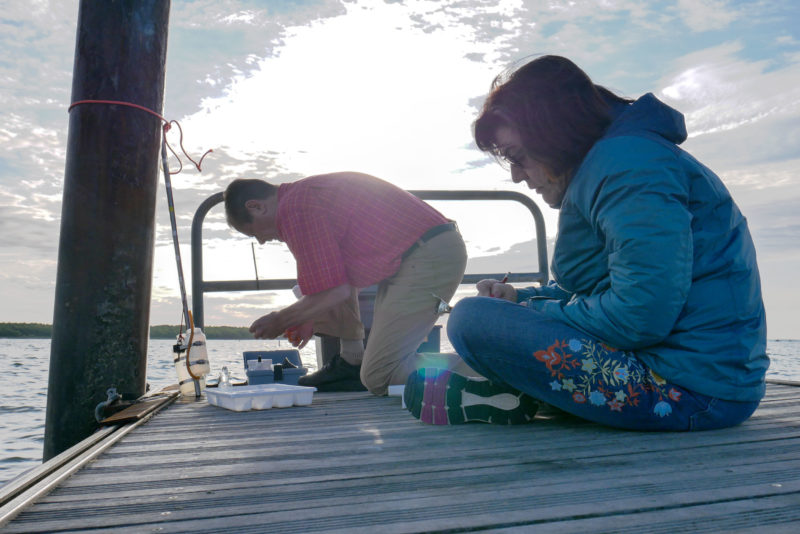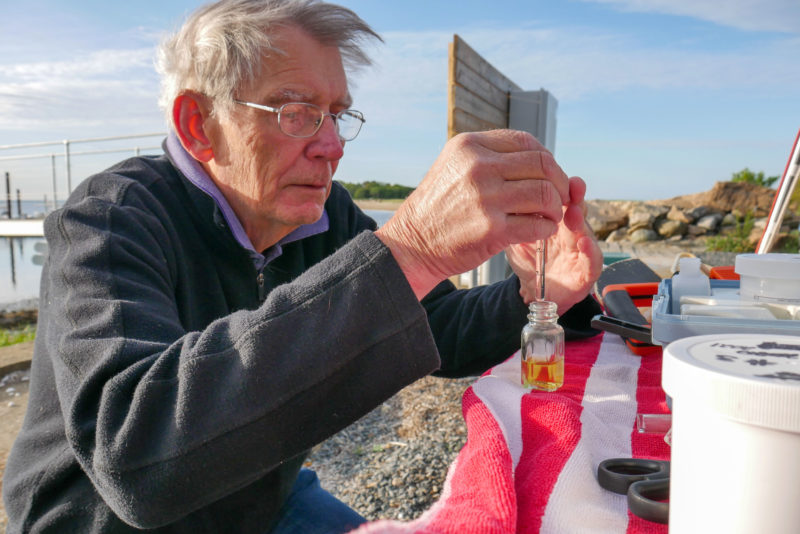Thirty years and hundreds of thousands of data points later
In the summer of 1992, a small group of citizens began gathering data on water quality in Buzzards Bay, seeking to understand the alarming changes taking place in harbors and salt marshes from Westport to Woods Hole.

Carl and Clara Boutilier collect water sample data for the Baywatchers program from the Fairhaven Town Boat Ramp on Little Bay.
That effort, now known as the Baywatchers water quality monitoring program, has continued uninterrupted ever since—through funding challenges, recessions, natural and manmade disasters, and a pandemic.
This year marks its 30th season of operation, making it one of the nation’s longest running and largest water quality monitoring efforts involving citizen scientists.
“This is an exciting milestone. The Baywatchers program is the foundation for all of our efforts to improve and protect water quality, and restore and preserve habitat on the Bay and in the watershed,” said Mark Rasmussen, president of the Coalition. “The success of our work depends upon solid science and an active community of people who care and are willing to act to protect our Bay. This program delivers all that.”
The program represents a unique partnership of trained community members, professional scientists, and two internationally renowned research institutions—Marine Biological Laboratory and the Woodwell Climate Research Center.

Baywatcher Peter Burlinson tests a water sample collected at Brandt Island Cove.
Coalition staff and citizen scientists (residents who have been trained) collect water quality information at more than 200 stations around the Bay each summer, from May through September, managed by Tony Williams, the Coalition’s director of monitoring programs. Data document the effects of nitrogen pollution including low oxygen that threatens marine life. Water samples are analyzed at the MBL in Woods Hole, under the direction of Woodwell Center Senior Scientist Christopher Neill and MBL senior laboratory technician Richard McHorney.
The resulting data is the foundation of the Coalition’s Bay Health Index, and it is used regularly by local municipalities, state agencies, and the federal government in guiding policy and managing activities on and around the Bay, said Rachel Jakuba, Ph.D., science director for the Coalition.
Earlier this spring, the first 28 years of the program’s data was published by the international journal Scientific Data, part of the publishing group that also publishes the prestigious journal Nature. In 2012, the program was honored by the EPA with its Environmental Merit Award. “It’s gratifying to see the Baywatchers data published, and it’s exciting to think about how it may inspire new studies,” Jakuba said.
“This is exactly what I had hoped for and wanted for this program,” said Joe Costa, Ph.D., executive director of the Buzzards Bay National Estuary Program (part of Massachusetts Coastal Zone Management), who helped launch the effort. “The Coalition has done a superb job in implementing this program, following the vision we had established for it and how it might serve Buzzards Bay.”
While the original vision remains constant, the particulars of the effort have changed a good deal over the years. For one, the number of testing sites has grown from 80 locations in the first year to more than 200. The range of sites has expanded to include spots at the head of estuaries as well as into Vineyard Sound, salt ponds on Martha’s Vineyard and several locations at the center of the Bay. And last year, 174 citizen scientists volunteered their time and effort to the program.
Tony Williams, the Coalition’s director of water quality monitoring, notes that he now manages the program from the organization’s new Marion Science and Field Operations Center, which opened in 2018. Prior to that, the program was managed from a succession of spaces, including a small storefront in the Village of Buzzards Bay and the Coalition’s headquarters in downtown New Bedford.
In addition, new equipment has enhanced the effort. The Coalition’s boat, Baykeeper, facilitates sample collection in the Sound and at other spots well away from shore. And in recent years, the use of autologgers in several locations has enabled round-the-clock monitoring at 15-minute intervals, providing new insights into the health of the Bay.
“Baywatchers would not have continued without the strong support and leadership at the Buzzards Bay Coalition to keep this program alive,” Costa said. “It’s really wonderful, and I’ve been ecstatic that the Coalition has built and grown this program.”